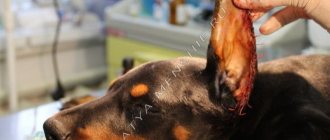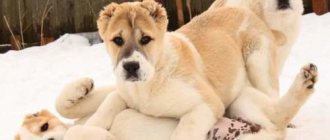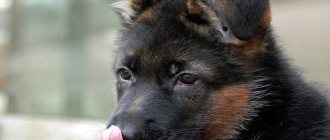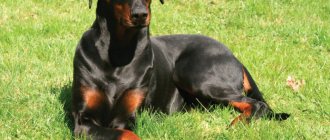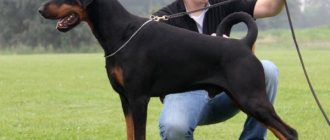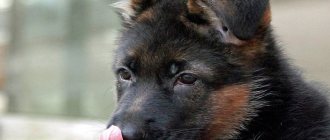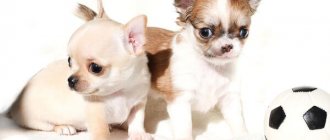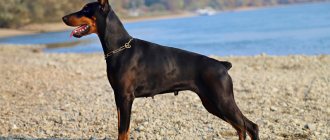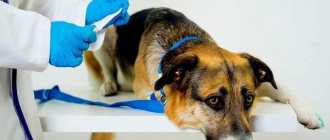The Miniature Pinscher is a dog breed that previously had its tails and ears docked in accordance with international standards. Later, this standard was changed, since docking was banned in many European countries. There is no official ban in Russia yet, but more and more opponents of the operation are emerging, since it causes pain to the animal.
In Russia, cases of docking miniature pinschers for decorative purposes persist
Why dock ears and tail?
The Miniature Pinscher breed was bred to protect houses and stables. To give the dog a frightening appearance, docking was carried out. Her ears were cropped to give them an aggressive, pointed shape. In a natural position, the ears will be pressed tightly to the temples.
Thanks to cropping, it is easier to care for the ears and reduces the risk of increased injuries during fights with other dogs.
The tail was docked for the same purpose, to protect the dog. The tail of this breed is long; during a fight, the enemy could cause significant harm. Attention! Since 1987, more than 10 developed countries have completely banned cupping.
This was achieved by animal activists and simply animal lovers. This procedure is reserved only for service and guard dogs; for others it is considered cruel and unnecessary. Russia has not yet joined this ban.
Mini Doberman Pinscher - miniature pinscher, active jealous and vigilant guard
The miniature pinscher, or miniature pinscher, was born in Germany. It was bred to hunt rats and guard convoys. An active, loyal, low-maintenance dog, over time it became a companion. The guard functions for which the smallest pinschers were bred are no longer needed, and the hunting functions have developed into intolerance to other animals.
Jealousy and the desire to be the only one who receives attention make raising a baby not so easy, but activity, sincere love for “their own” and a willingness to protect the whole family compensate for these shortcomings.
Purpose of the operation
Today, dogs of this breed are no longer used as guards, therefore, docking is no longer done for practical purposes. The operation is performed only for aesthetic reasons. Thanks to it you can give the dog elegance.
The Russian breed standard continues to support both docking and natural appearance. Without surgery, the dog's ears will be turned towards the temples, the inner edges will fit tightly to the cheekbones. They can be erect or hanging on cartilage. After cropping, the ears will definitely be erect.
Miniature Pinscher without cropped ears
Description of the breed
Miniature pinschers are proportionally built, they are short and stocky; Usually the ears and tail of such dogs are docked, but now more and more often on city streets you can see miniature pinschers in their so-called original form - without docked ears and tail, which is also not prohibited by generally accepted standards, which makes them even cuter; They are certainly smart, inquisitive and curious, they are like mercury - very mobile, and in general they have a wonderful character, cheerful and easy-going.
Some extravagance of some young miniature pinschers can be easily corrected with the help of unobtrusive training.
Appearance of a miniature pinscher
The miniature pinscher is distinguished by its very small stature: such dogs have only some 25-30 cm at the withers, versus 63-68 cm in adult Dobermans.
For comparison: the height of an adult Italian Greyhound at the withers reaches 32-38 cm, and the Pomeranian (Miniature Spitz) is even less - 18-24 cm, “no more than a thimble.”
A healthy adult male miniature pinscher can weigh 5 kg, and a female – 3.5-4 kg.
The miniature pinscher is characterized by well-developed bones and muscles, they are “compact”, and their high limbs are characterized as slender and elastic. Moreover, the hind legs in relation to the body are slightly laid back at a certain angle.
The Miniature Pinscher's head is not wide in the skull, with a visible transition to the muzzle with high-set pointed ears and a semi-flat forehead, which noticeably tapers to a perfectly black (like Malevich's famous “Square”), that is, without any pigment inclusions, fleshy nose. The neck is beautifully arched, rather narrow.
The standard bite of a Miniature Pinscher is called a scissor bite. Very expressive dark eyes are another distinctive feature of this breed. The coat is guard hairs without undercoat, smooth, hard, usually shiny. A high-set, erect tail is docked to a maximum length of 2.5 cm, but not shorter than 1.25 cm.
The standard of this breed provides for the colors black and tan (already as a stereotype, currently observed, perhaps, in the vast majority of individuals) and red, fawn. Brown and tan coloring is also common in the United States.
Character
The most striking definition for miniature pinscher dogs is a self-winding toy, a toy with a very powerful self-charging battery inside. Therefore, typical representatives of this “atomic” breed require a constant release of energy: frequent games in the fresh air, close communication with their own kind, long walks in the forest, along the banks of natural reservoirs, and so on.
And this creature will never sit still, at least for any long time, but will in every possible way seek adventure at that very point.
Miniature pinschers categorically do not accept loneliness, and therefore individuals of this breed should not be left alone in an apartment for a long time. Otherwise, it will definitely backfire on the owners, resulting in hopelessly damaged shoes or even furniture and peeled wallpaper, as well as puddles in the most inappropriate places.
Most common diseases
Despite the fact that in general this breed is characterized by good health, during the entire period of observation of its representatives the following diseases were recorded, and some of them qualify as hereditary, which the breeder usually knows about:
- Atrophy of the retina, in some cases leading to complete blindness;
- atrophy of the muscles of the hind legs, sometimes detected already in the first year of life and, as a consequence, lameness, and later development into a disease of the bones of the hip joint - Perthes disease;
- epilepsy of various forms;
- hypoterosis – hormonal disorders with the most unpredictable consequences for the dog’s body;
- dislocations of the kneecaps, either congenital or acquired.
Attitude towards children
Within their family, the attitude of miniature pinschers towards children is described as loyal, and the latter’s caring attitude towards the pet usually pays off with interest - mutual and most selfless love in such cases is guaranteed one hundred percent. In addition, the best way to unite children and pets is through common games and entertainment.
How many years do miniature pinschers live?
The average lifespan of a miniature pinscher is 12-15 years.
The benefits and harms of the operation
For practical purposes, it is not necessary to crop a Miniature Pinscher's ears. Many animal rights activists oppose this operation, considering it abuse of the dog. There are a number of positive and negative aspects of the procedure.
The benefits of cupping include the following:
- A miniature pinscher with undocked ears requires special care. He often develops inflammation, and the shells are difficult to care for.
- A docked tail is difficult to break or damage during games and fights with other dogs.
Opponents of the procedure highlight several negative nuances:
- The docked miniature pinscher is unemotional and has poor contact with other animals.
- Tail trimming leads to impaired motor skills.
Important ! But the most important argument is that docking causes dogs severe pain and the need to endure a difficult rehabilitation stage.
Photo gallery
In the photo selection below, we have collected representatives of the breed who have already undergone the ear cropping procedure. Perhaps these photos will help you decide on the advisability of this operation.
How many months do miniature pinscher ears crop?
Circumcision is performed at different ages. This should happen as early as possible, because small puppies tolerate surgery more easily. The tail is trimmed from the fourth to tenth day after birth. Ears can be cropped starting from the second month and ending with the third.
Adult canines have a hard time with such operations, or rather react poorly to anesthesia. The recovery period is more difficult for them. If surgery is performed on a large dog, complications may arise: a scar will appear, and the pet will develop mental illness due to the stress it has experienced.
The operation should be performed as early as possible
How to put ears on a miniature pinscher puppy
Placement of docked ears (one of the options):
So. We will need:
cotton-based plaster 2-2.5 cm wide; patch 0.5-1 cm wide; liquid for refilling lighters (hereinafter simply Liquid); ear cleaning sticks; cotton swabs for cleaning the face.
1. Take a wide patch, cut off a strip the length of an ear stick, and place it with the sticky side up. We wet the swab with lighter fluid and treat the sticky surface of the patch. Place an ear cleaning stick on top so that its ends do not extend beyond the patch.
2. Cut off the same piece of plaster and place it on top of the first piece with the stick sticky side up
We treat the sticky top patch with a swab containing liquid. 3. We treat the inner surface of the dog’s ear with a swab with liquid to degrease the skin (then the patch will last longer).
4. Glue our structure into the ear. It is necessary that the lower end of the stick rests somewhere inside the bend of the base of the ear. When you glue the structure, you insert the tip inside the ear, fix it with your fingers, then press this structure down, and pull the ear up strongly and then glue it. Those. the ear should be extended on a stick.
Now if the patch with the stick protrudes upward above the ear (most likely this will happen), then cut off the excess with scissors (be careful. Do not cut off the ear.), and bend the ends of the patch to the other side of the ear.
5. Pull the ear up and wrap it at the base with a thin plaster (do not lubricate it with liquid, otherwise it will come off along with the skin and all the fur). In this case, it is necessary to insert a finger into the ear and wrap it with a bandage at this time. This is to prevent you from over-tightening your ear. When you wrap the plaster and remove your finger, you will see that when examined from above there is a hole left, i.e. Air will flow into the ear and it will “breathe.”
Preparing the animal for surgery
The pet must be prepared for surgery in advance. It is recommended to undergo tests in advance to exclude the development of inflammatory processes. The dog owner must comply with the following rules:
- stop giving your pet food 12 hours before the upcoming surgery, limit it to water for three hours;
- if the puppy is not a newborn, then two weeks before the procedure he is given anthelmintic drugs;
- The cupping site needs to be shaved.
Important! The operation is performed only if the puppy is completely healthy.
How does the cupping procedure take place?
Miniature Pinscher docking should only be done by experienced veterinarians. At the moment, professionals offer ear cropping according to patterns using a scalpel. This procedure can be performed either in a clinic or at home. On the one hand, coming to the clinic is a good option, where sterility is guaranteed. But, in this case, the animal’s ears need to be bandaged during transportation. Surgical intervention at home also has both positive and negative sides. As they say, houses and walls heal. This rule also applies to animals. The dog will be less nervous and will be able to tolerate the procedure more calmly. In addition, you will no longer need to bandage, which promotes faster healing of wounds. But there is also a negative side. At home, no matter how hard you try, surgical sterility is difficult to provide. In emergency cases, which happen extremely rarely, the necessary drugs or equipment will not always be at hand.
So, if you decide to have surgery, first make an appointment with the veterinarian and get your dog ready. Twelve hours before the procedure, stop feeding, three hours before, stop giving water. This way the anesthesia works faster and better. After the operation itself, be sure to offer your dog some food and a drink of water. It is worth adding a painkiller to food to relieve pain after surgery. After recovery from anesthesia, the dog may vomit. Don't worry, this is a completely normal reaction of the body.
After surgery, the owner is responsible for caring for the animal. Immediately after recovery from anesthesia, the animal should put a tight collar around its neck - a lampshade. You can make it yourself from cardboard, or purchase it at a pet store. It is needed to prevent the animal from scratching its ears and thereby causing injury to an already painful area.
Treat the operated areas daily with an antiseptic and apply wound-healing ointment. If everything is done correctly, then in one and a half to two weeks the healing process will be completely completed, and you can move on to the next step - gluing the ears of the miniature pinscher .
Post-operative care
A miniature pinscher with cropped ears and tail will need careful care after surgery.
The docked tail should be carefully examined morning and evening, every day, so as not to miss the onset of the inflammatory process. Be sure to treat it with an antiseptic.
Cropped ears will have to be cleaned every day with hydrogen peroxide to remove dried crusts; after softening, they are carefully removed with a cotton swab. The procedure is very important, as scars may form at the site of damage. The edges of the ears are smeared with brilliant green.
Important ! It is recommended to wear a protective collar to prevent your pet from scratching its ears. Otherwise, it may cause infection in the wound.
One day after surgery, you can remove the bandage
Rehabilitation
How long should I wait before removing the bandage? It depends on the condition of the ears. The period varies from 3 hours to a day. Immediately after the anesthesia wears off, the dog should be given a small amount of food, since the miniature pinscher will experience hunger. It is necessary to provide proper care for the ears to speed up their healing. Painkillers are mixed into the food so that the dog does not feel pain in the area of the incision lines.
For 10 days after surgery, the dog must wear a protective collar, which can be purchased at a veterinary clinic.
It is important that the length of the walls at the collar reaches the tips of the ears, otherwise the dog will itch and damage the stitches. The threads usually dissolve within 10 days. If this does not happen, you need to contact a specialist to help speed up this process. To do this, the veterinarian carefully trims the threads and removes them himself.
Similar article: The main differences between the miniature pinscher and the toy terrier
Putting your ears in the correct position
The placement takes place four days after the sutures are removed. There are several ways to place your ears.
The simplest of them is the use of a structure made of cotton swabs and adhesive tape. The sticks need to be treated with alcohol or any other antiseptic, the ears and the inside of the shells should be lubricated with brilliant green.
A cotton swab is glued onto a seven-centimeter piece of adhesive plaster, and the same piece of plaster is placed on top. The adhesive layer must remain on the outside. The entire structure is attached to the inside. The base of the ears must be separately covered with adhesive tape, and the tape must be connected in the shape of a figure eight. In this case, the dog’s ears are wrapped one at a time to form a stable bridge. The dressing should be changed every four days. The ears will begin to stand up between four and twelve months. The process occurs most quickly in puppies up to three months.
Postoperative period after ear cropping in a miniature pinscher
After the anesthesia wears off, the dog begins to feel hungry, so it should be immediately given a small amount of liquid food. Give several more small portions throughout the rest of the day. To prevent your puppy from experiencing severe pain, add a painkiller to his food based on his body weight.
In the postoperative period, after removing the dressing, the wound must be treated for at least 7 days using a chlorhexidine solution. The stitches usually fall off within 10–14 days. If any of them remain, you need to treat them with a disinfectant solution and, using sharp scissors, carefully cut the loops between the edge of the ear and the knot and pull out the threads. Very often, puppies “remove” stitches on their own. Don’t worry, just treat the wounds with Dimexide and lubricate them with Vitaon ointment.
Usually, after some time, the operated areas begin to itch. The dog should not be allowed to scratch them. To do this, cut a circle out of thick cardboard and make a hole in the center of it. Bend the resulting “collar” around the neck into a cone with the socket forward, and fasten the edges with a rope. The dog should walk with this “collar” until the wounds are completely healed.
Is it possible to place ears without cropping?
It is not necessary that your pet’s ears will droop if surgery is not performed. There are ways to fix the ears of a miniature pinscher without cropping. The same frame is created as for dogs after surgery. The only difference will be that the bandage needs to be worn longer. At the same time, it is important to carefully examine the shells so as not to miss the inflammatory process.
A Pinscher with undocked ears will cost less than a puppy with cropped ears. This indicator plays the same role on the cost as the color of the pet.
Each owner must make a decision independently, taking into account all the nuances of the operation. The miniature pinscher is not a service dog, so docking is not required.
Carrying out the procedure
The cupping process is as follows:
- the puppy is placed on its stomach, its limbs are secured with special clamps;
- use restraints to immobilize the face and body;
- in the treated area, the fur is removed and disinfection is carried out;
- local anesthesia is given;
- The veterinarian secures each ear with a special clip and removes excess tissue.
The owner should be aware that the dog may wake up during such a procedure. If this happens, don't panic. Do not interfere with the doctor's completion of cupping. This is absolutely normal. The dog will not feel pain, since anesthesia has been given.
Remember that the dog senses the owner’s worries and worries. Your panic can cause stress in your pet. After the operation, the ears are glued with adhesive tape, giving the desired shape. Then a bandage is applied to the head.
How is ear circumcision performed?
The operation lasts 30-60 minutes and is performed either in a clinic or at home . After the dog has been secured and all the necessary antiseptic measures have been carried out, special metal patterns are placed on the ears.
For each breed, standard ear shapes are determined and stencils are cut out. They differ not only in shape, but also in length. The owner can choose a flat or s-shaped edge. And the ideal length is considered to be the size of the stump - the distance from the outer corner of the eye to the ear.
You need to put a protective Elizabethan collar on your pet, which will prevent scratching, wounds, and infection.
Caring for your dog after surgery
After the operation, the puppy’s ears are tied with bandages to ensure proper formation of cartilage, which ensures beautiful posture. Not all breeds need this. Within 2-4 days after the procedure, pets are usually given analgesics, painkillers that reduce the pet’s anxiety. Wearing a collar is mandatory. You should also limit your dog's interaction with other animals to avoid injury.
Education and training
The Miniature Pinscher dog breed is excellent at remembering and following commands.
But there is a fine line that the trainer will have to walk: the dog must not be allowed to take liberties and must not be treated roughly. In order for the miniature pinscher to learn the commands seriously and for a long time, you will have to repeat their execution many times before moving on to the next ones. This is why raising and training this breed takes longer than other dogs.
But overcoming obstacles is something that the mini pinscher does with great pleasure. This small dog is able to jump over an obstacle five times its height. Miniature Pinschers are one of the best breeds for agility and obstacle jumping competitions.
When training on your own, you need to tune in to each lesson. The dog must feel confident, calm in its owner and his firm intention to achieve what he wants.
Miniature pinscher nutrition
Despite their active lifestyle and lively character, miniature pinschers are prone to obesity. Buying a miniature pinscher and feeding it sausages and sweet gingerbread from the master’s table is a bad idea.
Your four-legged friend needs a healthy, balanced diet. Dog handlers recommend sticking to either natural products or dry food. Both diets are suitable for Pinschers. Mixing them is contraindicated.
The choice in favor of natural food obliges owners of miniature pinschers to fill their pet’s diet with meat by at least 40%. It is desirable that it constitutes 60% of the foods consumed by the dog.
Recommended are horse meat, veal, and beef. From the list it is clear that lean meat has a beneficial effect on the health of pinschers. You can give chicken, game, offal such as liver, tongues, and offal.
Vegetables and cereals complement meat in the miniature pinscher's diet. As a rule, dogs eat the latter with great pleasure. This recommendation does not apply to puppies.
For the first month they only need mother's milk. It can be replaced by specialized mixtures. From a month onwards, the stomachs of newborns accept goat's and cow's milk, liquid porridges cooked on them.
From 1.5-2 months, when the puppies have adapted to porridge, minced beef is introduced into the diet. After another couple of days, you can give finely chopped fillet. Soups with a small addition of cereals begin to be served at the same time as minced meat.
Up to 2 months, puppies are fed natural products. Afterwards, you can switch to special dog food. It is important to choose items that are high in protein. From 2 months, the percentage of foods in the diet of miniature pinschers is compared with the requirements of adult dogs. Only the number of feedings differs.
Up to 7 months, adolescents need 2 feedings per day. Adult pinschers eat 5-6 times, washing down their meals with plenty of water. Therefore, it is imperative to have a container of clean water next to the food bowl.
The character of the miniature pinscher and its care
The miniature pinscher in the photo resembles a Doberman and, like the “big brother,” belongs to the group of Great Danes. It includes not only pinschers, but also miniature schnauzers. In character, the hero of the article is closer to the latter.
Representatives of the breed are playful and active. The liveliness of miniature pinschers is combined with natural suspiciousness. This helps to raise a guard dog out of a dog, but requires the owners to use a tight rein.
Sensing weakness in the owner, pinschers turn into domestic tyrants. Therefore, the price of a miniature pinscher is rarely of interest to families with children, or those who are getting their first four-legged friend.
The hero of the article is a selection of experienced dog breeders who have training skills and know how to be the main one in the “pack”. Intellectually, training a miniature pinscher is easy. Representatives of the breed are smart and quick-witted.
Combined with endurance, excellent scent, attentiveness and vigilance, this makes pinschers excellent hunters. As a rule, representatives of the breed get animals out of holes. Duck hunting with a pinscher is rather an exception, although the dog is an excellent swimmer.
The guardian instinct in the miniature pinscher awakens before six months, usually at 3-4 months. We are preparing for a dull growl at the door. At home it can be annoying. Pinscher owners are lenient towards their barking on the street.
If in the old days dogs ran behind horse-drawn carriages, now they become companions on bike rides and hiking trips. Miniature pinschers don't even care about mountains. If the rocks are not steep, your four-legged friend will be able to climb them.


